 Get premium membership
Get premium membership and access revision papers with marking schemes, video lessons and live classes.
Form 1 Agriculture Notes on Livestock Production
Grade/Class: Form 1
Subject: Agriculture
Term: Select Term
Document Type: PDF
Views: 7160
Downloads: 6
Summary
LIVESTOCK PRODUCTION (COMMON BREEDS)
Livestock Breeds
Livestock breed refers to all animal selected and reared for production in the farm.
These animals are of various species namely; cattle, camels, bees, fish, sheep, goats, pigs, poultry and rabbits. The term breed refers to a group of animals having the same characteristics and a common origin.
Most of the farmers in Kenya select breeds to keep from the above types of livestock species
Terms used on livestock
Bull:- mature male cattle
Bullock:- Mature castrated male cattle
Steer:- Young castrated male cattle
Cow:- Mature female cattle
Heifer:- Young female cattle between weaning and first calving.
Calf:- Young one of cattle
Piglet:- A young pig from birth to weaning
Gilt:- A young female pig from weaning up to first parturition
Boar:- A mature male pig
Chick: – Newly hatched bird from one day to eight weeks.
Pullet: - Young female bird from eight weeks to the point of lay.
Cockerel: - Young male bird from eight weeks to maturity.
Hen:- Mature female bird
Cock:- Mature male bird
Layer: – Bird kept for egg production
Broiler:- Bird kept for meat production
Capon:– Bird which has been rendered sterile
Ram:- mature male sheep
Ewe: – Mature female sheep
Lamb: – A young one of a sheep
Hogget:– Young female sheep between weaning and service
Billy:- Mature male goat
Nanny:- Mature female goat
Kid: – Young one of goats
Kindling:- Young one of a rabbit
Buck:- Mature male rabbit
Doe:- Mature female rabbit
Breed:– a group of animals with similar characteristics and common origin.
Field trip
The teacher to take students out for a field trip at Kenya agricultural research institute nearest to you.
During the visit the students should do the following.
i.) List all the livestock breeds available within the station
ii.) List their origin
iii.) List other livestock breeds not within the station
iv.) Classify various livestock breeds according to their products. After the visit student should write a report and hand in for marking
Guidelines for marking the report. -Teachers tips
Classification according to their products.
Exotic dairy cattle breeds
Indigenous beef cattle breeds
Dual purpose cattle breeds
Sheep meat breeds
Wool sheep breeds
Dairy goat breeds
Meat goat breed
Draught animals are used for transportation and ploughing in the farms.
For example donkeys, camels and oxen.
Livestock Production (Common Breeds)
* name the seven species of livestock
* define the terms, livestock, breed and type
* describe all breed characteristics
* state the origin of all the breeds
* classify all the breeds into types
* name the external parts of all the livestock species.
LIVESTOCK SPECIES Common Breeds)
These species of livestock are covered in this lesson;
* Cattle,
* Camels,
* Sheep,
* Goats,
* Pigs,
* Poultry
* Rabbits
* Bees,
* Fish.
Livestock Distribution in Kenya
TYPE OF LIVESTOCK SPECIES, POPULATION AND THEIR PRODUCTS
Cattle population in 2006 was 12.5 million
Produces Milk, meat among others
Goats population in 2006 was 11.0 million
Sheep population in 2006 was 8.0 million
Produces Wool, meat among others
Pigs population in 2006 was 330,000 thousand
Produces Pork, Bacon among others
Chicken population in 2006 was over 29 million
Produces Eggs, meat among others
Rabbits population in 2006 was 470,000 thousand
Produces Skin, Meat among others
Camels population in 2006 was 850,000 thousand
Bees
Produces honey, wax among others
Fish
Produces white meat, oil, animal feed among others
The country produces livestock products worth Kshs 290 billion annually.
Characteristics Exotic Cattle Breeds
Have no humps
Intolerant to high temperatures
Susceptible to diseases
Fast growth rate
High production
Short calving intervals
Cannot walk long distances
Exotic Cattle Breeds population was around 3.5 million in 2006
Characteristics Indigenous Cattle Breeds
Long calving intervals
Have humps
Walk long distances
Slow growth rate
Poor production
Tolerant to high temperature
Resistant to diseases
Indigenous Cattle
Indigenous Cattle Breeds population was around 9 million in 2006
General characteristic of indigenous cattle breeds
Have hump that store fat
Tolerant to tropical diseases eg. Trypanosomiasis
Low production
Can walk for long distances
Can stay for long without water
Long calving interval
Importance of livestock
Livestock products provide food to people e.g. meat, milk, eggs, honey and blood Medium of exchange of goods
Source of income when sold locally or exported
Cultural values e.g. status symbol, social ceremonies and recreational purpose.
Animal power e.g. draught power needed for pulling carts or ploughs.
Provision of raw materials to industry e.g. wool, dung, hides and skin
CATTLE BREEDS
CHARACTERISTICS OF DAIRY CATTLE
Large and well developed udder
Udder is firmly attached and not pendulous
Teats are uniform size, well spaced and long
Large long and branching mammary veins
Large stomach
Good feeder
Good strong legs and well set hind quarters
Have a straight top line.
Long lean and smooth neck
Wedge or triangular-shaped when viewed from the sides
Examples of dairy cattle
Fresian (Holstein)
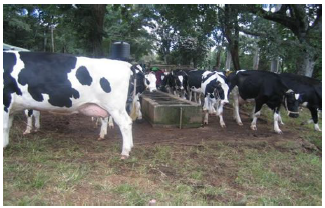
Origin: - Holland
Colour: - Black and white body
White forehead legs and switch.
Size: - Average mature cows weigh 600-680Kg live weight
- Average mature bulls weigh 900-1000Kg live weight
- Average mature calves weigh 35-40Kg at birth. Milk yield: - 9000kg an average lactation of 305 days
- Butterfat content 3.5%
- Tolerant to cold but not heat
Ayshire
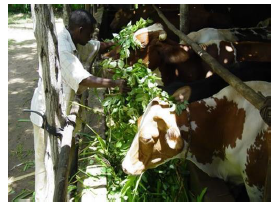
Origin: – Scotland
Colour: – Brown with white markings
Size: - Average mature cows weigh 500Kg live weight
- Average mature bulls weigh 700kg live weight
- Average mature calves weigh 30 -35kg at birth. Milk yield: – 6000kg lactation of 305 days
- Butter fat content 4%
Guernsey
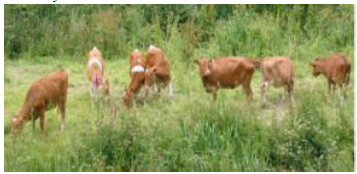
Origin: - Guernsey island (Coast of France)
Colour: - Yellowish brown to almost red with white marking on the legs, face, girth and tail
Size: - Average mature cows weigh 500kg live weight
- Average mature bulls weigh 700kg live weight
- Calves weigh 25 – 30Kg live weight
- Buffer fat content 4.5-5.0% Temperament: – Quiet and easy to handle
- Good grazers
- Fairly hardy and tolerate moderate heat
Jersey
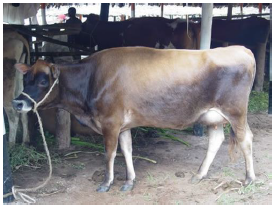
Origin: - Jersey island in English channel
Colour: - Light yellowish brown (fawn) to a shade of black.
Black eyes, tail switched and muzzle
Size: - Average mature cows weight 450kg live weight -Average mature bulls weight 600kg live weight
- Calves weight 20-25kg at birth
Milk yield: - 4000kg per lactation of 305 days
- Buffer fat content 5.53%
Temperament: - Bulls are aggressive and vicious
- Excellent grazers on poor pastures -Cows are nervous and sensitive -Resistant to high temperature
CHARACTERISTICS OF BEEF CATTLE
Good foragers on poor pastures
Short legged
Breed regularly
High ability to convert feeds in fresh
Tolerance to high ambient temperature
Resistance to diseases as compared to dairy breeds.
Have square rumps and heavy quarters
Deep chest and girth
Grow fast and mature early
Have deep well flashed body
The body conformation is blocky, square or cylindrical appearances. The top and lower lines are almost straight.
Examples of the beef Cattle Breeds
Boran
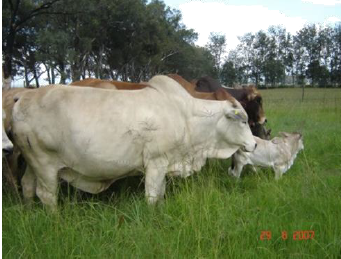
Zebu
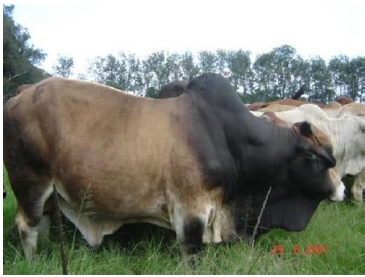
Boran and zebu (Most important indigenous beef breeds) other breeds include Ankole, Bukandi, Maasai and Nandi cattle
CHARACTERISTICS OF IMPROVED BORAN & ZEBU
Short neck
Brood head and muzzle
Straight and broad back
Loss skin having short fine hair
Short and straight horns or polled
Average live weight (Cows 450 – 500kg) (and bull – 800kg)
Regular breeding ability
Can withstand drought and heat
Can walk for long distances in search of pasture and water
High quality meat
Has large hump that store fat to provide energy and water in times of starvation.
Resistance to tropical diseases e.g. Tryponosomiasis
Good grazers a forager even on poor posture or shrubs
EXOTIC BEEF BREEDS
Aberdeen Angus
Origin: - Scotland
Suited to highland areas only
Color: - Black with long smooth coat
Shape: Cylindrical compact broad and deep
Size: - Mature bulls weigh 900kg live weight
- Mature Cows weigh 720kg live weight
- Poor breeder
Hereford
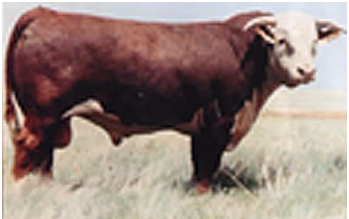
Origin: – England
Colour: - Deep red with white tail, lets, flanks hocks and brisket
Size: - Average mature bulls weigh 1000kg live weight
- Average mature cows weigh 850kg live weight Shape- Beefy confirmation with large hind quarters
Charolais
Origin: – western France
Color: - White or creamy white
Shape: - Polled or short horns and well fleshed
Size: - Average mature bulls weigh 1200kg live weight Average mature cows weigh 1000kg live weight
Galloway
Origin: – South West Scotland
Colour: – Black weigh brownish tinge
Size: – Average mature bulls weigh 1000kg live weight
Average mature cows weigh 700kg live weight
Shape: – long body with thick undercoat with long hair
Short horns
Origin: - north East England
Colour: – Red, roan or white
Size: – Average mature bulls weigh 800kg live weight Average mature cows weigh 600kg live weight
Shape – Small body
- Fast growth rate
-Yellowish horns with black tips
DUAL PURPOSE CATTLE BREEDS
These breeds combine qualities of both dairy and beef animals. Therefore they are good in production of both milk and beef.
Sahiwal
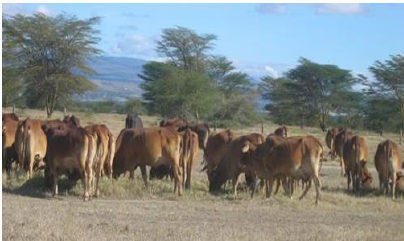
Origin – India and Pakistan
Colour – Reddish brown to silver
Size – Average mature bulls weigh 500kg -650kg live weight
- Average mature calves weight 40kg at birth Shape – Large dew lap and loose naval flap
- Breed forehead,
- Polled with long ears
- Deep body with short legs
Milk Yield – 2700kg per lactation of 305 days
-Butter fat content t of 3.7%
-Difficult milkers
Simmental
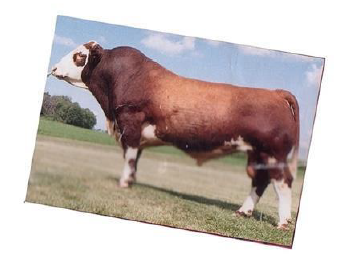
Origin- Switzerland
Colour- Light red with white patches and white head Size: Smaller than Sahiwal but with fast growth rate
Shape – Broad and straight back that are well fleshed on the in quarters Udder is well attached with large teats
Strong, short straight legs
Temperament- Docile, and adaptable to hot climate Milk yield: -3600kg per lactation of 305 days -Butter fat content of 4.0kg%
Red Poll
Origin: England
Colour: Deep red with white nose
Size: Average. Cow weigh 450kg live weight
Shape – Strong short legs that are fleshed
- Polled
Milk yield: 2500kg per lactation of 305 days
Butterfat content 3.0%
Suitable for semi-arid areas.
CHARACTERISTICS OF BEEF CATTLE
Good foragers on poor pastures Short legged
Breed regularly
High ability to convert feeds in fresh Tolerance to high ambient temperature
Resistance to diseases as compared to dairy breeds. Have square rumps and heavy quarters
Deep chest and girth
Grow fast and mature early Have deep well flashed body
The body conformation is blocky, square or cylindrical appearances. The top and lower lines are almost straight.
Examples of the beef Cattle Breeds
Boran
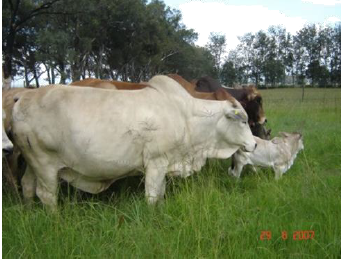
Boran is one of the most common indigenous beef cattle.
Zebu
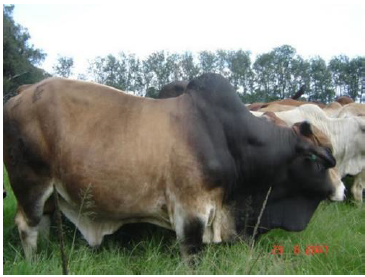
Boran and zebu (Most important indigenous beef breeds) other breeds include Ankole, Bukendi, Maasai and Nandi cattle
Livestock Production (Common Breeds)
Goats
Goat breeds
Meat goats
East African goats
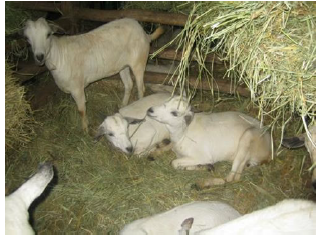
Origin :- Indigenous breeds in semi-arid areas
Colour :-Range from pure white to pure black with speckles or roan and brown
Size:- Mature buck weigh up to 35 kg live weight
- Mature nanny weigh up to 25-30kg live weight
- Take 5-6 months to mature
Production: – good for meat production in harsh condition
Galla goat (also known as Boran, Somali goat, Samburu)
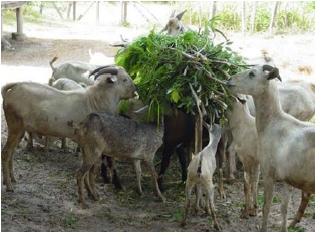
Origin:- Indigenous to Northern Kenya
Colour:- White hairs with black skin, nose, feet and under the tail
Size:- -Mature buck weigh upto 40-50 kg liveweight
- Mature nanny weigh upto 25-30 kg liveweight Temperament:- Docile and easy to handle Production:- Good for meat production
Boer goat
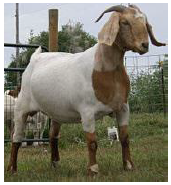
Origin: – South Africa
Colour: - Mixed black and white with long hair and ears
Size: - Fast maturing
Anglo – Nubian goat
Origin:- North East Africa
Colour:- Mixed roan with white
Shape:- Long legs palled and drooping ears
Production:- Mature nanny weigh 60-75 kg live weight -Goat for eat and milk production
-Can produce 1-2 liters of milk per day
Jamnapari goat
Origin: – India
Colour: - Ranges from white roan to black
Shape:- Horned, Ears are large and flopped
Production:- Mature nanny weigh 45-60kg live weight -Kept for meat production though can produce
1-1.5 liters for milk per day
Dairy goat breeds
Toggenburg
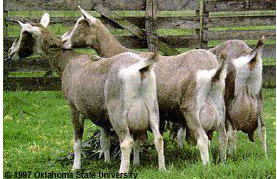
Origin: - Switzerland
Colour: - Brown with white patches
-White ears and white stripe on the face and neck Shape:-Polled or horned. Horns in males are long and curved
-Erect ears pointed backwards long hair, face slightly dished and has tassels on either
-Side of the neck
Production:- mature nanny weigh 40-50 kg live weight -Produces 2-3 litres of milk per day
-Butter fat content 3.5%
Temperament:-Suffer from heat stress resulting in poor appetite.
Saanen goats
Origin:- Switzerland
Colour:- White or creamy white
Shape :– Usually polled
-Ears are erect and pointing forward
Production: – Mature nanny weigh 50-80 kg live weight
-Produces 2-3 litres of milk per day butterfat content 3.5%
Kenya Alpine
Origin: – Germany
-Being used to upgrade the local breeds for milk production Colour: – brown with black strip at the back
Shape: – Horned
Production: – Mature nanny weigh 50-60 kg liveweight produces 2-3 litres of milk per day
Livestock Production (Common Breeds)
Camel
Species of camels
There are two species of camels, one single humped, its origin is Arabia and its known as Dromedary,
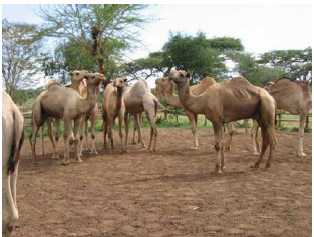
Dromedary is the only breed kept in Kenya .
Bactrian has two humps and is from Central America.
Livestock Production (Common Breeds)
Parts of a Pig
Pig breeds
Large white
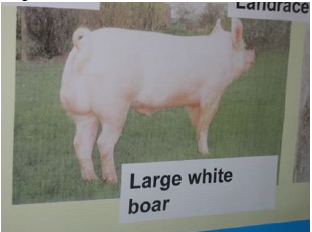
Originated from Britain
-Widely kept for production of Pork
Shape and colour
- Long, large and white pig
- Skin may have few blue spots
-Snout is broad and slightly dished
-Ear are upright
Growth rate
- slow weigh about 300 kg -Boar weigh about 350 kg
Land race
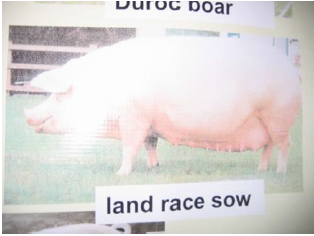
Originated from Denmark
-Commonly kept for bacon production
Shape-long lean pig
-Has a straight snout and long ears drooping over the face -Hams are deep and broad
-Weak legs
Grow rate - has ability to put on large amount of lean meat quickly Sows are prolific and docile
Berkshire
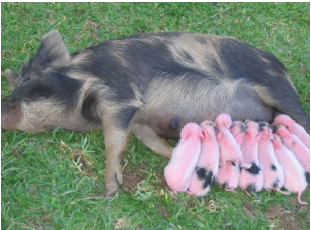
Origin- England
Colour-Black with white feet, face and tail switch
Shape-Dished face and erect ears
Production-Good producer of bacon.
Tam Worth
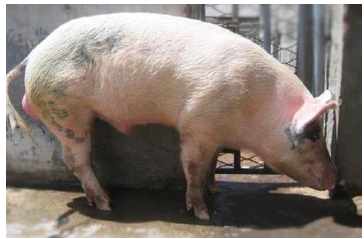
Origin-England
Colour- Red, varying from light to dark
Shape- Has long legs
Production- Good bacon producer
-Poor mothering ability with slow grow rate
Saddle back
Origin:- South of England
-Includes both Essex and wessex saddle back
Colour:- Black with white band that runs around the shoulders
Shape:- Body is long and curved
It has a straight snout and drooping ears
Production:- Excellent mothering ability
-Good for port and becon production
-Good forager
Duroc Jersey Pig
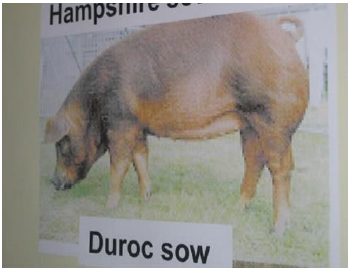
Origin: Britain
Colour: Pure black
Shape: Long strong frame
Production: Sows produce large litters with good mothering ability Fast growth and early maturing
More Notes